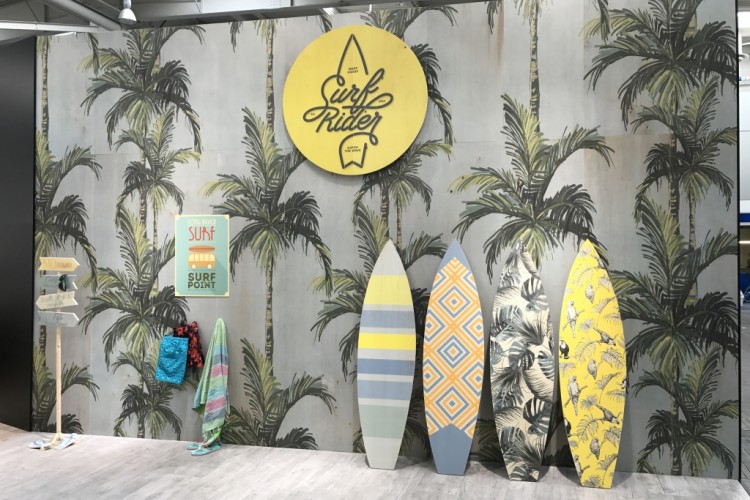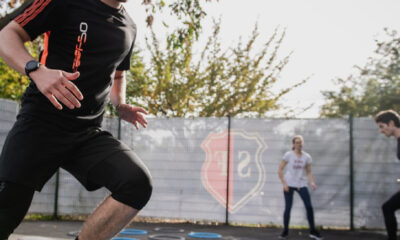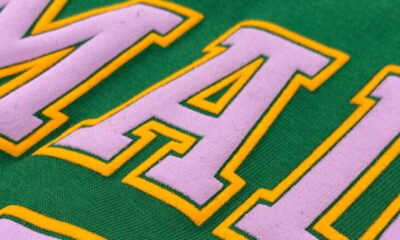Trends
Single-Pass Inkjet and the Wide World of Décor
High-speed industrial inkjet technology is expanding into décor applications including laminate flooring, furniture, doors, and more.
Published
7 years agoon

MANY DIGITAL GRAPHICS companies have profitably diversified into décor, showing architects and interior designers what’s possible with short-run inkjet printing of wallcoverings, upholstery fabrics, tabletops, artwork, and flooring. Yet inkjet printing has barely scratched the surface of its potential in the massive décor market.
Now, developers of industrial inkjet printers are focused on building high-speed, application-specific printers for use by commercial manufacturers of products such as bed linens, upholstery, furniture, doors, flooring, countertops, wallpaper, decorative tile, and wall panels. Although industrial inkjet printers from companies such as Durst and EFI Cretaprint have already revolutionized ceramic tile decoration, tiles account for just a fraction of the interior surfaces that could be decorated with digital printing. As the manufacturers refine the single-pass technology that was first aimed at markets such as commercial printing and labels, they’ve set their sights on what may prove to be bigger game in the décor industry.
Consider just one of the many market segments that could be poised to adopt inkjet technology in a significant way: the decorative laminates used in walls, floors, ceilings, countertops, partitions, shelves, cabinets, doors, furniture, storage units, and much more. Laminate floors and countertops are manufactured to simulate the look of natural materials such as wood or stone, and are popular because they are more affordable, more durable, and easier to maintain. Plus, laminates made from recycled materials are attractive to builders, decorators, and building owners who care about stopping deforestation and conserving natural resources.
Printed décor is quite literally all around us, and the possibility of slicing lead times and run sizes makes inkjet an appealing option for today’s manufacturers. Courtesy of Industrial Inkjet.
You may not realize how prevalent laminates are until you start looking for them, as I did recently. I noticed that laminate panels are used on the reception desk, lockers, and bathroom countertops at my gym. My office desk is made from laminated wood. So are the bathroom stalls at the Mandalay Bay Hotel’s convention center in Las Vegas.
Because laminates are found in nearly every home, hotel, store, restaurant, and office building, they represent a huge opportunity for growth in industrial inkjet printing. To look at just one application, Global Industry Analysts projects that the global market for laminate flooring will reach 17.2 billion square feet by 2020, due to improving construction activity, technological advancements, and design innovations.
Yet in some applications such as countertops, laminates have been steadily losing market share to engineered and natural stone, metals, concrete, and recycled materials. Inkjet could reverse that trend. Laminates are manufactured in a variety of ways depending on the use: Floors and furniture are made from composite granulated or chipped woods that are pressed together at high temperatures and bonded with melamine resin; countertops are made from layers of plastics bonded on top of particle board or layers of Kraft paper.
Regardless of the construction, print plays a critical final role. To create the desired aesthetics, an image printed on a plastic film, paper foil, or thin sheet of wood (veneer) is bonded to the surface of the laminate. Ultimately, the quality of the printing determines whether the laminate looks cheap and cheesy or as beautiful as the natural product it simulates. Analysts at Freedonia believe high-definition graphics that provide a more stonelike appearance, which today’s inkjet technology makes possible, may help limit the decline of laminated countertops. Freedonia projects that by 2019, laminates will still account for about one-third of total countertop sales, expected to reach 810 million square feet and a value of $29.3 billion that year.
Laminates are a compelling application because aesthetics alone could drive significant growth for inkjet. But throughout the décor world, other market forces such as consumer demand for customized goods, pressure from retailers to cut lead times and order quantities while offering a wider range of options to shoppers, and the growing realization that offshore mass manufacturing may no longer meet the changing market’s needs are creating an ideal environment for inkjet. Smaller quantities of customized goods that must be delivered rapidly simply do not play into the strengths of traditional analog printing technologies.
Single-Pass Inkjets for Décor Printing
The scale of these applications will require fast, reliable, purpose-built production lines, which is where single-pass inkjet technology comes in. Single-pass inkjet printers use stationary printbars that span the full width of the print surface. Instead of making multiple passes back and forth across the print surface, as traditional wide-format printers do, a single-pass system applies all of the ink as the material moves rapidly beneath the printbar.
Single-pass inkjet printers that use water-based inks are already used in commercial printing, corrugated package converting, and textile printing. Narrow-format single-pass systems that use water-based or UV-curable inks are also in wide use in the label industry. The technology isn’t new to the décor market – Barberán, a company we’ll discuss in just a moment, has offered such systems for a decade – but more players are entering this sector as awareness rises and single-pass technology advances. Some are familiar names to wide-format print service providers; others have a background as OEMs or systems integrators of other types of production equipment used in these industries. Building single-pass inkjet printers robust enough for industrial environments can cost millions of dollars and require years of testing. Typically, single-pass lines are designed to print the standard-size materials already used in higher-volume manufacturing processes.
Here is a quick rundown of currently available and recently announced digital décor printing technology.
Barberán Jetmaster Series
 Founded in 1929, Barberán is a family-owned business that makes industrial surface finishing machinery for the furniture, construction, and decoration industries. The company had a head start in attacking the opportunity in décor printing: They have been making single-pass UV inkjet printers for 10 years, equipment that is reportedly used in 30 factories. Barberán has four main divisions, including one for digital printing, with the R&D resources needed to develop all machine components and software.
Founded in 1929, Barberán is a family-owned business that makes industrial surface finishing machinery for the furniture, construction, and decoration industries. The company had a head start in attacking the opportunity in décor printing: They have been making single-pass UV inkjet printers for 10 years, equipment that is reportedly used in 30 factories. Barberán has four main divisions, including one for digital printing, with the R&D resources needed to develop all machine components and software.
Barberán’s Jetmaster Series of single-pass printers uses four or six colors of UV-curable inks to print 360-dpi variable-drop, grayscale images at speeds up to 180.5 feet per minute. The optional six-color inksets are available with either light cyan/light magenta or orange/violet.
Jetmaster printers can be built to image panels as narrow as 1.18 inches and as wide as 74.4 inches. Standalone models come in widths such as 33 inches, 41.3 inches, 49.6 inches, and 66.1 inches. Options include a primer station and a finishing unit for gloss control.
Most Jetmaster printers are designed for MDF (medium-density fiberboard); HDF (high-density fiberboard) for flooring; wood panels; or melamine laminates for furniture, cabinets, and display counters. A roll-to-roll Jetmaster unit can print the thermoplastic foils used to wrap components with contoured edges and surfaces such as door frames and other decorative moldings. Specialized machinery can be built to print on cork, linoleum, or glass.
EFI Cubik
 In January, EFI announced plans to develop a single-pass line for the décor market at its Connect user conference. The new EFI Cubik print line was revealed to the public in May at the Ligna 2017 woodworking show in Hannover, Germany. Based on EFI Cretaprint’s single-pass line for the ceramic tile industry, Cubik is envisioned not as a single model but as a family of single-pass printers built for specific segments of the décor industry. As with the Cretaprint line, EFI will be leveraging its printer, ink, and color management capabilities to provide fully integrated systems in each market it addresses.
In January, EFI announced plans to develop a single-pass line for the décor market at its Connect user conference. The new EFI Cubik print line was revealed to the public in May at the Ligna 2017 woodworking show in Hannover, Germany. Based on EFI Cretaprint’s single-pass line for the ceramic tile industry, Cubik is envisioned not as a single model but as a family of single-pass printers built for specific segments of the décor industry. As with the Cretaprint line, EFI will be leveraging its printer, ink, and color management capabilities to provide fully integrated systems in each market it addresses.
Limited details about the Cubik unit displayed at the Ligna show were available at press time, but it featured a 71.4-inch print width and was printing images directly to a variety of wood products and laminates at speeds up to 246 linear feet per minute. The system used UV LED inks and can be configured with up to eight printing bars, allowing for a variety of decoration effects beyond CMYK printing.
SPGPrints Pike
As reported in the June/July 2016 issue, four companies are currently manufacturing single-pass textile inkjet systems: MS Printing Solutions (the LaRio), Konica Minolta (the Nassenger SP-1), Atexco (the Honghua Vega-1), and SPGPrints (the Pike). SPGPrints recently announced two new Pike models for the décor market at the 2017 Heimtextil show in Frankfurt, Germany.
 Unlike the original Pike system, which uses water-based inks for textile applications, the two new models both use UV-curable inks. The Pike 700 printer uses a 27.6-inch central impression cylinder with fixed-array printheads and curing units to apply graphic images, textures, and protective coatings to the laminating foils used to make floors, wall panels, and countertops. Surfaces such as stone, wood, brick, and ceramic tiles can be printed and then finished with gloss, matte, satin, or silk coatings. Textures can also be added to enhance the look and feel of the laminated surfaces. The second new Pike model, at 51.2 inches wide, is designed to directly print doors, tabletops, ceiling tiles, and panels.
Unlike the original Pike system, which uses water-based inks for textile applications, the two new models both use UV-curable inks. The Pike 700 printer uses a 27.6-inch central impression cylinder with fixed-array printheads and curing units to apply graphic images, textures, and protective coatings to the laminating foils used to make floors, wall panels, and countertops. Surfaces such as stone, wood, brick, and ceramic tiles can be printed and then finished with gloss, matte, satin, or silk coatings. Textures can also be added to enhance the look and feel of the laminated surfaces. The second new Pike model, at 51.2 inches wide, is designed to directly print doors, tabletops, ceiling tiles, and panels.
Both new Pike printers use SPGPrints’ Archer variable-drop technology. SPGPrints is currently working on a line of printers for wallpaper manufacturers.
Industrial Inkjet CP562
Konica Minolta and Industrial Inkjet have collaborated to develop a single-pass inkjet printing system that they believe could be competitive with conventional wallpaper printing methods in terms of productivity, production speeds, and cost per roll. At the 2017 Heimtextil show, the companies invited wallpaper producers to see a demonstration of a single-pass inkjet system for digitally printing typical media at linear speeds up to 230 feet per minute.
John Corrall, managing director of Industrial Inkjet, believes digital printing of wallpapers will expand beyond specialized applications such as wall murals: “Our view is that wallpaper printing is about to see a massive shift to digital technology thanks to the improvements in inkjet capability.”
 The unit displayed at the Heimtextil show was based on the company’s Print Engine CP562 (its standard color print engine for applications such as wallpaper printing requiring a 22.1-inch print width). The company is also offering a larger 27-inch version designed for the second standard wallpaper width. The CP562 uses Konica Minolta KM1024i grayscale printheads with 360 x 720-dpi resolution. Unlike analog wallpaper printing systems, the repeat length is virtually limitless.
The unit displayed at the Heimtextil show was based on the company’s Print Engine CP562 (its standard color print engine for applications such as wallpaper printing requiring a 22.1-inch print width). The company is also offering a larger 27-inch version designed for the second standard wallpaper width. The CP562 uses Konica Minolta KM1024i grayscale printheads with 360 x 720-dpi resolution. Unlike analog wallpaper printing systems, the repeat length is virtually limitless.
One big challenge in creating the demo system was formulating an ink that would not only work on a wide range of common wallpapers, but would also meet indoor air quality standards and durability tests. Corrall indicates that the solution came through a water-based polymeric formulation that is thermally fixed onto the media after printing.
The unit was displayed printing matte images onto a variety of standard wallpaper media including paper, PVC, and non-woven materials. Textured and pre-embossed media can also be printed on the system. The engines are available as standalone units with media transports, dryers, and image-verification systems, or as retrofit digital modules to be incorporated into existing production lines.
The Long View
It might take years for manufacturers of décor products to fully embrace what might be possible with high-speed, single-pass inkjet printers. “The InPrint Décor Survey and Report” published in 2016 by the organizers of the InPrint Show, I.T. Strategies, TCM Conference Management, and IMI Europe confirmed that décor is poised to be the next big area of growth for industrial inkjet. But the survey also identified factors that may be delaying adoption of inkjet technology. Factors include a lack of expertise by potential users, and concerns about perceived ink costs and the ability to successfully print on challenging surfaces. It may also take time for the manufacturers in these industries to develop business models to leverage such dramatically different production capabilities, though the tile industry offers a compelling example of how quickly a market can embrace these ideas. For now, the one certainty is that we’re just seeing the beginning of single-pass inkjet for décor applications.
Eileen Fritsch is a Cincinnati-area-based freelance writer who served as assistant editor of Screen Printing magazine in 1994 before being named a founding editor of Big Picture magazine.

SPONSORED VIDEO
Let’s Talk About It
Creating a More Diverse and Inclusive Screen Printing Industry
LET’S TALK About It: Part 3 discusses how four screen printers have employed people with disabilities, why you should consider doing the same, the resources that are available, and more. Watch the live webinar, held August 16, moderated by Adrienne Palmer, editor-in-chief, Screen Printing magazine, with panelists Ali Banholzer, Amber Massey, Ryan Moor, and Jed Seifert. The multi-part series is hosted exclusively by ROQ.US and U.N.I.T.E Together. Let’s Talk About It: Part 1 focused on Black, female screen printers and can be watched here; Part 2 focused on the LGBTQ+ community and can be watched here.
You may like
Advertisement

Inkcups Announces New CEO and Leadership Restructure

Hope Harbor to Receive Donation from BlueCotton’s 2024 Mary Ruth King Award Recipient

Livin’ the High Life
SUBSCRIBE

Bulletins
Get the most important news and business ideas from Screen Printing magazine's news bulletin.
Advertisement
Latest Feeds
Advertisement
Most Popular
-

 Case Studies2 months ago
Case Studies2 months agoHigh-Density Inks Help Specialty Printing Take Center Stage
-

 Art, Ad, or Alchemy2 months ago
Art, Ad, or Alchemy2 months agoF&I Printing Is Everywhere!
-

 Andy MacDougall2 months ago
Andy MacDougall2 months agoFunctional and Industrial Printing is EVERYWHERE!
-

 Columns3 weeks ago
Columns3 weeks ago8 Marketing Mistakes Not to Make When Promoting Your Screen Printing Services Online
-

 Editor's Note2 weeks ago
Editor's Note2 weeks agoLivin’ the High Life
-

 Thomas Trimingham2 months ago
Thomas Trimingham2 months ago“Magic” Marketing for Screen Printing Shops
-

 Marshall Atkinson2 weeks ago
Marshall Atkinson2 weeks agoHow to Create a Winning Culture in Your Screen-Printing Business
-

 News & Trends1 month ago
News & Trends1 month agoWhat Are ZALPHAS and How Can You Serve Them in Your Print Business?













